Chinese Name: 北京海洋馆 Pronunciation: Běijīng Hǎiyángguǎn
Recommended Visiting Time: 3-5 Hours
Occupied Area: About 120, 000 square meters
Address: No. 6, Qixiang Road, Haidian District, Beijing, China
| Tourists | Ticket Price | |
| Adults (18-59 years old) |
Peak Season (April 1st to October 31st) |
Low Season (November 1st to March 31st) |
| 175 yuan | 170 yuan | |
| Minors (under 18 years old, excluding 18 years) |
85 yuan | |
| Seniors (aged 60 or above with valid ID card) |
85 yuan | |
Children who are below 1.2 meters, accompanied by adults, are free of charge.
| Peak Season (April 1 to October 31) |
Low Season (November 1 to March 31) |
|
| Opening Hours | 9:00-17:30 | 9:30-17:00 |
| No Entry Time | 17:00 | 16:30 |
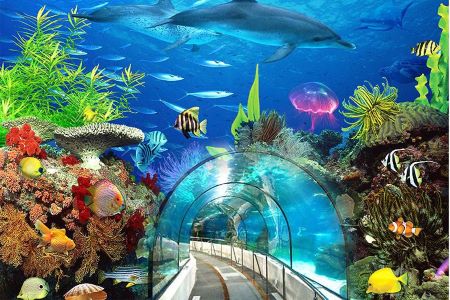
The Beijing Aquarium is located in Beijing Zoo, neighboring Beijing Exhibition Centre, Beijing Planetarium, and Capital Gymnasium. It covers 120,000 square meters with a building area of 42,000 square meters and a green area of more than 80,000 square meters.
The Beijing Aquarium, the top aquarium in China, is a modern and advanced marine life science museum. It has a world-leading life support system. The total amount of its artificial seawater reaches 20,000 tons.
Its biological collection is of the largest number in China. It feeds and displays marine creatures of more than 1,000 species. The number of fish is about 30,000 to 50,000, including tens of thousands of marine ornamental fish and freshwater ornamental fish from nearly 1,000 species. Besides the ornamental fish, performances by mammals, such as dolphins and sea lions, have impressed the visitors.
The whole structure of the Beijing Aquarium is like a conch painted in blue and orange. The colors represent the mysterious sea and the endless vitality of marine creatures.
With various fish displays and promotions to protect rare and endangered species, fantastic marine animal shows and other activities to introduce knowledge on marine creatures, visitors will comprehend the charm of marine creatures and be aware of the importance of environmental protection.
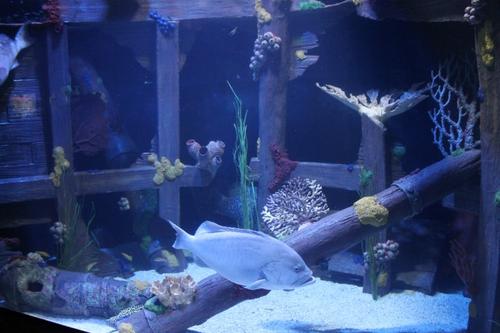
Enter into the Rainforest Adventure Zone, you will see the meandering roads, waterfalls, old bridges, and mysterious statues, hearing stream gurgling flowing, birds singing, and small insects chirping, just like you are walking in the Amazon old-growth rainforest. The Rainforest Adventure represents a landscape of the South American rainforest and shows freshwater fish. You shall watch redtail catfish, kio fish, gar, pirarucu, etc.
Shark Town is composed of a shark aquarium and a fishing port town. The most famous vision is the full-frame underwater 3D mural with about 70 meters long, 5 meters high, and a total area of 380 square meters. The theme of this big-size mural is “swallowed sea city”. The sunk sea city aims to advocate attention to environmental protection.
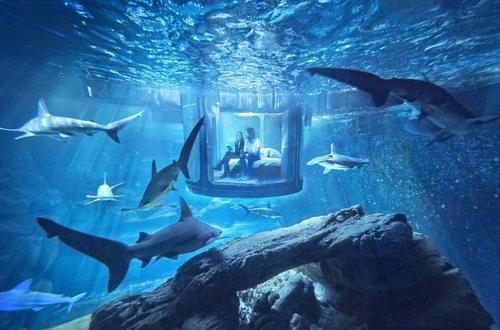
The pond of the shark aquarium is about 30 meters in length, and about 6 meters high, and water storage of the pond reaches 1,200 tons. The acrylic exhibition window is about 9 meters long, 4 meters high, 20 centimeters thick, and 17 tons in weight, and its total area is about 42 square meters.
The shark aquarium is applied to an advanced water recycling system. It enables the seawater quality in a natural harmonious condition by continuous water cycling, filtration, and bacterial decomposition.
The Chinese Sturgeon is one of the most primitive fish species in the world and a special and valuable fish peculiar to the Yangtze River in China. The Chinese Sturgeon has good reputation of “panda of the water” and “the kingfish of the Yangtze River”.
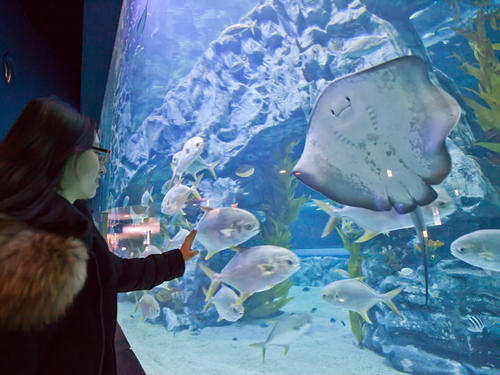
One of the attractive fish is the Stingray in the Wonders of Coral Reefs. The Stingray lived in the Jurassic period of the Mesozoic era (about 180 million to 140 million years ago). It is flat in a round or rhombic shape with a long flagelliform tail. The Stingray has no bone and squama, swimming like a butterfly. It likes staying beneath the sand to hunt for fish or shellfish.
The Chinese Sturgeon (Latin name: Acipenser Sinensis) is the largest fish in the Yangtze River, called “the kingfish of the Yangtze River”. The Chinese Sturgeon can date back to 140 million years ago when dinosaurs were alive, therefore, it is called “the living fossil in the ocean”. The sturgeon is one of the most endangered fish species, 63% of which are critically endangered, and 30% of which are in the threatened or vulnerable or endangered species. The survival sturgeon species are listed in the Red List of Threatened Species by IUCN (International Union for the Conservation of Nature). The sturgeon, therefore, is also called the “panda of the ocean”.
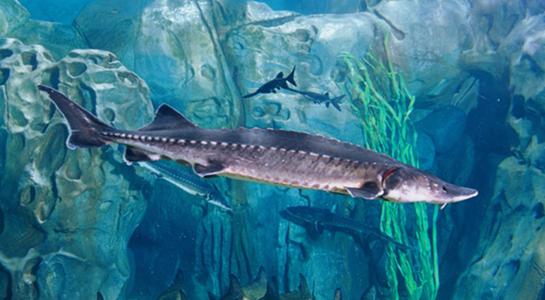
In summer and autumn, the Chinese sturgeon will return to the Yangtze River from the ocean. They may go on a journey about 3,000 km to the Jinsha River (upper Yangtze River) because they need to give birth and feed their babies. And when their babies grow up to about 15 cm, they go back to the ocean with their babies. Generation after generation, the Chinese Sturgeon was born in the upper Yangtze River, and grow up in the sea.
The Chinese Sturgeon enjoys a long life cycle, and the oldest one may live for 40 years. As the oldest vertebrate animal on the earth, the Chinese Sturgeon embodies surprising academic value because of its primitive characteristics in studying fish evolution. It is listed as one wildlife under first-class protection by the Chinese government.
| The Beijing Aquarium Performance Schedule | ||||
| Dolphins and Sea Lions Show | Location | Marine Mammal Pavilion | ||
| Date | Low Season | Peak Season | ||
| Monday - Sunday | Monday - Friday | Saturday - Sunday | ||
| Time | 11:30; 15:00 | 11:00; 13:30;15:00 | 11:45; 12:15; 13:30; 15:00 | |
| Diving Show | Location | Wonders of Coral Reefs | ||
| Date | All Seasons | |||
| Monday - Sunday (except Tuesday) | ||||
| Time | 10:30; 13:30 | |||
The Good Taste Island Restaurant beside the Chinese Sturgeon Aquarium provides visitors with an ocean family combo, fried squid, beef rolls and rice, chips, etc. Next to the restaurant is a leisure area that also serves food, one of which is a popular nutritional meal for children.
Walking out of the Chinese Sturgeon Aquarium, you will see a fried food shop. In the Bering Strait, you will enjoy ice cream in the cold drink shop.
Enter from the Rainforest Adventure→ Shark Town→ Bering Strait→ Chinese Sturgeon Aquarium→ Wonders of Coral Reefs→ Wholphin Exhibition→ Marine Mammal Pavilion
| Restrooms | Baggage Storage | Baby Care Room |
| On both sides of Bering Strait; along the right side of Good Taste Island Restaurant; in Wonders of Coral Reefs; in Marine Mammal Pavilion |
Free storage for trolleys, scooters, or locked suitcases only. Backpacks cannot be stored. | Please ask the staff at the information desk or the ticket counter. |
Take bus 305, get off at Cixiansi Bridge Station.
Take bus 16, 26, Yuntong 103, or Yuntong 105, get off at Beijing Jiaotong University Station
If you get off at Cixiansi Bridge Station, you need a walk about 90 meters along the Gaoliangqiao Xiejie( 210 meters if you get off at Beijing Jiaotong University Station), and then turn left, walk about 110 meters along the Jiaotong University Road, walk 370 meters along the Qixiang Road, turn right to the destination.
(Note: The North Gate of Beijing Zoo is closer to the Beijing Aquarium.)
Take Metro Line 4, get off at Beijing Zoo Station, and exit A. After that, you need a 10-minute walking.
Chinese: 请带我去北京海洋馆。English: Please take me to the Beijing Aquarium.
If you go to the Beijing Aquarium from the center of Beijing (Grand Hyatt Beijing), it takes about 45 minutes (about 45 yuan).
If you go to the Beijing Aquarium from Beijing Capital International Airport, it takes about 55 minutes (about 90 yuan).
If you go to the Beijing Aquarium from Beijing Daxing International Airport, it takes about 1 hour and 20 minutes (about 165 yuan).
If you go to the Beijing Aquarium from Beijing West Train Station, it takes about 30 minutes (about 40 yuan).
